Prairie Rose, Climbing Rose, Climbing Prairie Rose, Climbing Wild Rose, Illinois Rose, Michigan Rose - Rosa setigera
|
Rosa setigera - Prairie Rose, Climbing Rose, Climbing Prairie Rose, Climbing Wild Rose, Illinois Rose, Michigan Rose. While it's pretty easy to identify a wild rose as a rose, I have avoided particular species identification because there is usually significant variation within species, and significant similarities between species - it can be very difficult for a non-expert like me. There are over 30 wild rose species in North America. Rosa segitera - Prairie Rose - is a climbing shrub or vine with fewer leaflets per leaf (3 or 5) than most other wild roses, making its identification easier.
Rosa setigera is an attractive plant which is sometimes cultivated, has been used as a hybrid in cultivars to enhance their hardiness, and is an attractant to birds who eat the bright red hips. While it is a native North American plant, it is likely not native to the easternmost and southernmost parts of its current range. The photos on this page are of a plant in Tennessee, where it is native.
Found in:
AL, AR, CT, DC, FL, GA, IA, IL, IN, KS, KY, LA, MA, MD, MI, MO, NC, NE, NH, NJ, NY, OH, OK, PA, SC, TN, TX, VA, WI, WV, GS
Leave comments on Rosa setigera at this link. | 
Distribution of Rosa setigera in the United States and Canada:

Map courtesy of The Biota of North America Program.
Map color key
Search Our Database: Enter any portion of the Scientific, Common Name, or both.
Do a general Google search of the entire site:
#ad
 Follow USWildflowers on Twitter
#ad
| | Site: Coffee County, TN Date: 2016-June-01 | Photographer: Gerald C. Williamson
Nikon D7000
Tamron SP 90MM f/2.8 AF Macro | | The deep pink-hued flowers of Prairie Rose are about 2 to 3 inches across. The styles are joined together into a column that extends further above the stylar orifice at the base of the petals than most other wild roses within its distribution range. | | 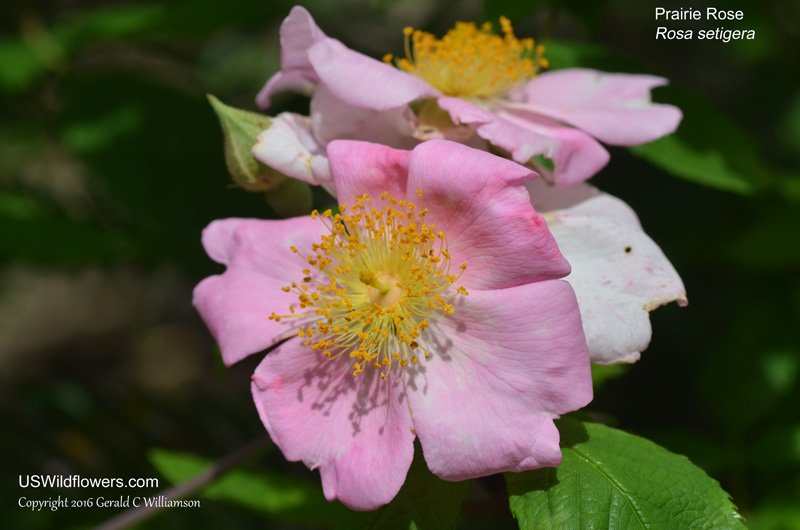
| | Site: Coffee County, TN Date: 2016-June-01 | Photographer: Gerald C Williamson
Nikon D7000 | | The pedicel and sepals of Prairie Rose are stipitate-glandular. The flower has many - perhaps as many as 200 - yellow stamens. | | Click on the photo for a larger image
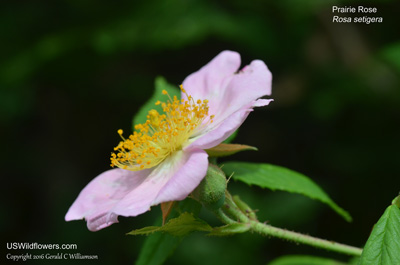
| | Site: Coffee County, TN Date: 2016-June-01 | Photographer: Gerald C Williamson
Nikon D7000 | | Rosa setigera is a climbing shrub with stems that can grow to 12 or 15 feet long. If there is nothing to support the climbing habit, it will arch and reroot where it touches the ground. It will have many deep pink flowers which can fade to nearly white. After blooming, the hips turn a deep red. | | Click on the photo for a larger image
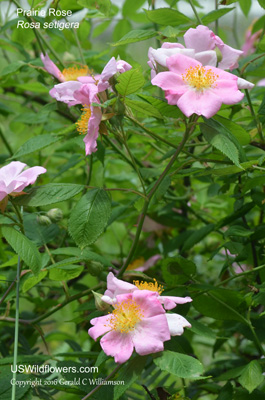
| | Site: Coffee County, TN Date: 2016-June-01 | Photographer: Gerald C Williamson
Nikon D7000 | | Most leaves - those on the younger stems - on Prairie Rose have three leaflets. Each leaflet will usually have 20 to 40 teeth per side; more than similar Multiflora Rose, which usually has fewer than 20 teeth per side, and will have 7 to 9 (occasionally 5 or 11) leaflets. The stem petiole is densely stipitate-glandular. | | Click on the photo for a larger image
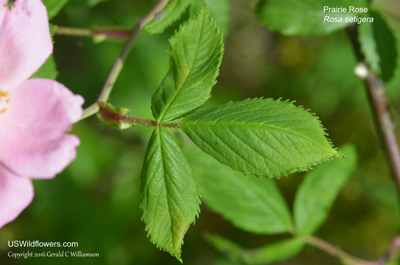
| | Site: Coffee County, TN Date: 2016-June-01 | Photographer: Gerald C Williamson
Nikon D7000 | | The leaves on the older stems may have 5 leaflets. | | Click on the photo for a larger image
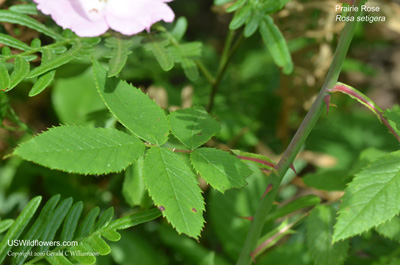
| | Site: Coffee County, TN Date: 2016-June-01 | Photographer: Gerald C Williamson
Nikon D7000 | | Rosa setigera has a stipule which is joined to the petiole for most of its length. The stipule margins are mostly entire or ciliate, unlike the similar but invasive Rosa multiflora, which has fringed stipules. The underside of the margins of the stipule on R. setigera may be stipitate-glandular, which could give the appearance of being fringed on a casual inspection. The stem of R. setigera is glabrous, and has somewhat widely-spaced prickles. (I have recently learned that on roses these are technically not thorns - thorns are modified stems. These are instead prickles, which are outgrowths of the epidermis of the stem.) The prickles on R. setigera are usually curved, but may occasionally be straight. | | Click on the photo for a larger image
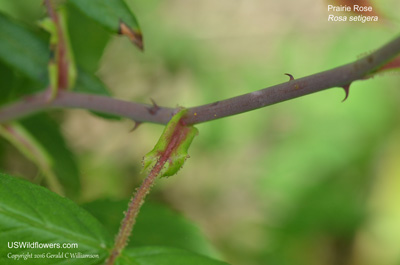
|
References used for identification and information:
|
|
| |
| #ad
|
|








